Adaptive Systems
-
- Vessel Specific Training Via Adaptive Learning Experience Maritime Reporter, Mar 2013 #34
It is difficult and expensive to do vessel-specific training well. This is probably why, unlike certification training, it is under specified, and in many cases poorly implemented - often via job shadowing. But there is a technology which is an excellent tool for vessel-specific training, and every vessel operator should be aware of it. It is called adaptive learning. This article describes adaptive learning and examines one vessel operator’s deployment of it in order to facilitate vessel-specific training across its fleet of 35 vessels.
Certification training is well defined and regulated by the STCW and the various flag state regulations. Course lists are specified, course curricula are provided and even model courses are available to guide trainers.
However, there is another training component which is arguably just as important, yet it goes largely unregulated and is only minimally specified: vessel-specific training. Broadly speaking, vessel-specific training covers the unique combination of vessel characteristics, layout, equipment, and operating procedures and routines found on a vessel.
It has always been the case that crews needed to be deeply familiar with their vessels in order to operate them safely. But in recent years this need has become much more critical and urgent in light of the continuously increasing sophistication and complexity of modern vessel-based systems. Simply knowing how to operate these sophisticated systems is not sufficient. A deeper understanding is required in order to facilitate intelligent problem solving when the systems are not behaving as expected or, worse yet, when interactions between multiple sophisticated on-board systems produce unpredictable behaviours and outcomes. Crews must be armed with the knowledge necessary to make an informed analysis and arrive at a logical decision. It is the responsibility of each vessel operator to ensure this is so. However, this is much more easily said than done.
The Problem
For vessel operators, delivering standardized, comprehensive training of each vessel’s complex systems and procedures across their fleet can be a daunting task. To illustrate, let’s look at an example.
Consider a vessel operator which manages 50 vessels. These vessels are never uniform. There may be five different types of propulsion systems over the 50 vessels. Bridge equipment is not uniform. Fire fighting systems differ sometimes in their type and manufacturer, and differ always in their layout and implementation. Life rafts differ, marine evacuation systems differ, ship handling differs, and even the route that the vessel is currently operating on can require different reactions to an otherwise similar situation. The fact that each vessel differs from the others in some fundamental way means that the routines and procedures on board can never truly be the same. To further complicate matters, equipment, routines and training practice are all always in flux. So even if a training manual could be written for each vessel, it would be out of date in short order. So how can a vessel operator efficiently create, maintain and continuously improve a standardized, vessel-specific training program when the knowledge requirements vary so much from one vessel to another and changes and updates are an almost continuous necessity?
The answer is that many operators don’t do vessel-specific training particularly well. Instead, they resort to highly imperfect techniques such as job shadowing, sometimes combined with small amounts of classroom-based training. Fortunately, the technique of adaptive learning can provide a solution.
What is Adaptive Learning?
Adaptive learning is a computer-aided training technique designed to tailor each training instance to the needs of the individual trainee.
Although this may sound complex, it can be surprisingly simple and highly effective. In general, adaptive systems “learn” about each trainee and then adapt the learning content and interaction to fit him or her.
How can this be applied to vessel-specific training? The best way to illustrate is to look at how British Columbia Ferry Systems Inc. (BC Ferries) uses adaptive learning to provide vessel- and route-specific training across its 35 vessels serving 47 ports on 25 routes.
Adaptive Learning at BC Ferries
BC Ferries is leveraging adaptive learning across all operational lines of business (Deck, Terminals, Catering, and Engineering).
Taking a deckhand as a specific example at BC Ferries, the actual knowledge required will vary tremendously depending on the vessel and route combination within which the deckhand will be working. Specifically, there are several different types of knowledge required:
● Core knowledge: This is also referred to as “Fleet-generic knowledge” and is the same for all deckhands at BC Ferries. This includes company vision/mission/values, deckhand core competencies, safety, security and environmental policies and information.
● Vessel-specific knowledge: This is the required knowledge pertaining to the vessel that the deckhand will be operating on. It includes equipment on that vessel, procedures unique to that vessel, and so on. It consists of hundreds of pieces of knowledge, the combination of which will be unique to that vessel.
● Route-specific knowledge: This is the required knowledge pertaining to the route the deckhand will be operating on.
● Vessel-Route knowledge: This is knowledge required which is unique to the specific combination of vessel and route that the deckhand will be operating on. For example, operating procedures for the vehicle ramps at the various terminals will often differ based on which vessel is at the terminal.
Obviously for BC Ferries, as for any vessel operator, the creation and maintenance of custom training programs for every possible combination of job position, vessel and route would not be possible as it would number in the many thousands. Even if we took routes out of the equation, the number of distinct training programs required for every combination of job position and vessel would number in the hundreds, rendering their creation and continuous improvement not financially viable.
Instead, BC Ferries uses technology to provide the necessary training resources efficiently through adaptive learning. The trainee experience is now as follows. When an employee begins his or her training, BC Ferries’ learning management system (made by the company I work for) asks the employee to specify three pieces of information:
● What position they are training for,
● What vessel they will be operating on, and
● What route they will be operating on
With the answers to the questions above, the LMS assembles the required knowledge on demand and generates a customized, up-to-date, seamless, and cohesive learning package for that employee, in that position, on that vessel, while operating on that route. The effect is as though someone created, by hand, a learning program specifically targeted for that employee. These learning materials (available online or on paper) are now used to support comprehensive vessel-specific training for that employee at BC Ferries.
The same is true for assessments. When a test is about to be administered, the LMS asks for the position, vessel and route being trained. The examination is then created on demand to address the competencies and knowledge specific to that combination.
The Advantages of Adaptive Learning
For the Learner
The advantages of adaptive learning are reasonably self-evident for the learner. He or she is provided with a learning program which is specifically targeted at the knowledge needed. It is cohesive and seamless and does not require the trainee to judge whether this or that bit of information applies to their position while on their vessel and route. It all applies. More importantly, adaptive learning makes this kind of deep vessel-specific (and route-specific, in this case) training possible where otherwise it would be a practical impossibility.
For the Training Organization
(this is important …)
The advantages to the training organization are possibly even greater. Aside from the greatest benefit of improved training, adaptive learning creates efficiencies in learning content creation and maintenance - the same ones that make vessel-specific training possible. To understand them, a small bit of background is required.
When creating learning materials for an LMS which supports adaptive learning, one “learning module” is created for every “thing” that needs to be trained. For example, if in a fleet of 50 vessels there are three different ECDIS systems, then three modules are created for ECDIS training - one for each different ECDIS system. If four different RADAR units are dispersed across the fleet, then four modules are created for RADAR - one for each unit. This is replicated for the various equipment and procedures which need to be taught. When these modules are entered into the LMS database, they are tagged with the positions, vessels or routes (or any combination of the above) to which they apply. Now, as described above, when a learner specifies their position, vessel and route, the LMS software gathers all the relevant learning modules and, using a “framework”, assembles them into a customized training document which can be delivered to the trainee.
Now perhaps the advantages to the training organization become more clear. First, in a fleet of 50 vessels, it is not necessary to write a separate, complete training program for each vessel. Instead, each procedure or piece of equipment to be trained is documented only once in one small module, and then that module is tagged to indicate which vessels, positions, etc. it applies to. There is no redundant work required.
More importantly, maintenance of the courses is now very manageable. If a vessel has its ECDIS machine swapped out for another, all that is required is the changing of one tag in the LMS database to indicate which ECDIS machine now applies to that vessel. From that point on, training for that vessel will encompass the correct ECDIS machine. Likewise, if the training for one procedure or one class of ECDIS machine is updated to reflect some new information or an improved training approach, only that one learning module needs to be updated, no matter how many vessels or positions that one module is relevant to. From that point on, all trainees in positions or on vessels to which that learning module applies will immediately have the improved training experience. It is in this way that deep vessel-specific training is made possible and practical by an LMS which supports adaptive learning.
The BC Ferries Perspective
Adaptive learning has been an important tool in the implementation of BC Ferries new approach to training called the “Standardized Education and Assessment program”. According to Jeff Joyce, Director of Fleet Operations at BC Ferries:
“The Standardized Education and Assessment (SEA) program is a fundamental safety enabler from both the training and employee engagement perspectives.
Being able to easily tailor programs for each learner ensures relevant, precise and targeted teaching is taking place. This, coupled with equally surgical examination questions and processes ensures that the learner, upon successful completion of the multi-modal clearance process, is fully capable of safely carrying out his or her duties and thereby provides real value to the greater team. Viewed from a different perspective, the Master looking at his or her teams on the bridge and at the mooring stations can be confident that all deckhands who have gone through this program have had equal opportunity to learn all requisite knowledge. The larger team also collectively knows that the SEA graduates have proven to themselves and their shipmates that they have the knowledge (and equally important, the confidence) to proactively participate in all evolutions, be they routine or unforeseen.
The corollary benefit of BC Ferries SEA program, which so ably leverages adaptive learning, is that the maintenance and upkeep of the program is actually completed by the vessel subject matter experts (SMEs), thereby sustaining the engagement of these employees on the deck plates - the SMEs are enabled to keep the material relevant and then reap the rewards of their efforts by working side-by-side with their shipmates who have completed SEA training. This process of quality training material being delivered and maintained by SMEs results in confident, capable graduates. These new teammates frequently become engaged trainers themselves once they’ve honed their knowledge and skills with experience...resulting not only in an almost self-sustaining cycle of training success, but more fundamentally, safer operations and enhanced customer service.”
Conclusion
The advantages of adaptive learning to maritime industry training cannot be overstated. Properly applied, it makes vessel-specific training not only possible, but also highly practical and sustainable where previously it was neither. Given the importance of vessel-specific training in this era of ever increasing complexity of vessel systems and procedures, this technique is one which is critically important now and will only increase in utility and applicability as time marches on.(As published in the March 2013 edition of Maritime Reporter & Engineering News - www.marinelink.com)
-
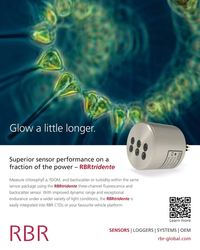 )
March 2024 - Marine Technology Reporter page: 4th Cover
)
March 2024 - Marine Technology Reporter page: 4th CoverGlow a little longer. Superior sensor performance on a rmance on a – – RBRtridentfraction of the power RBRtridente teee ackscatter or turbidity with hi i in n n t t th h h he e e s sa a am m m me Measure chlorophyll a, fDOM, and backscatter or turbidity within the same e e sensor package using the
-
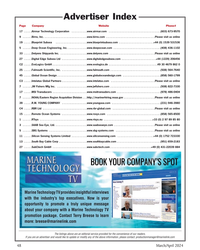 )
March 2024 - Marine Technology Reporter page: 48
)
March 2024 - Marine Technology Reporter page: 48Index page MTR MarApr2024:MTR Layouts 4/4/2024 3:19 PM Page 1 Advertiser Index PageCompany Website Phone# 17 . . . . .Airmar Technology Corporation . . . . . . . . . .www.airmar.com . . . . . . . . . . . . . . . . . . . . . . . . . . . . . . . . .(603) 673-9570 9 . . . . . .Birns, Inc. . . . . . . . . . .
-
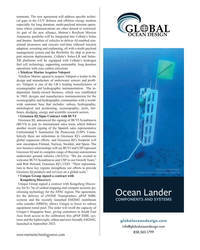 )
March 2024 - Marine Technology Reporter page: 45
)
March 2024 - Marine Technology Reporter page: 45ronments. The new agreement will address speci? c techni- cal gaps in the UUV defense and offshore energy markets especially for long duration, multi-payload mission opera- tions where communications are often denied or restricted. As part of the new alliance, Metron’s Resilient Mission Autonomy portfolio
-
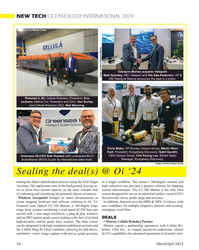 )
March 2024 - Marine Technology Reporter page: 44
)
March 2024 - Marine Technology Reporter page: 44NEW TECH OCEANOLOGY INTERNATIONAL 2024 Image courtesy Metron/Cellula Teledyne Marine acquires Valeport: Matt Quartley, MD, Valeport and Ole Søe-Pedersen, VP & Image courtesy Teledyne Marine GM Teledyne Marine announce the deal in London. Pictured (L-R): Cellula Robotics, President, Eric Jackson, Metron
-
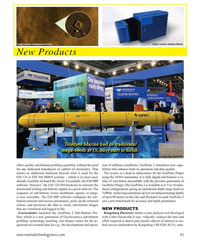 )
March 2024 - Marine Technology Reporter page: 43
)
March 2024 - Marine Technology Reporter page: 43Image courtesy Kongsberg Discovery Image courtesy Teledyne Marine New Products Teledyne Marine had its traditional mega-booth at Oi, busy start to ? nish. Image courtesy Greg Trauthwein offers quality sub-bottom pro? ling capability without the need tion of offshore windfarms. GeoPulse 2 introduces new
-
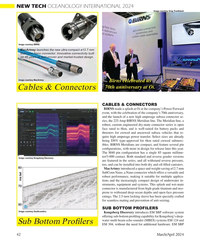 )
March 2024 - Marine Technology Reporter page: 42
)
March 2024 - Marine Technology Reporter page: 42NEW TECH OCEANOLOGY INTERNATIONAL 2024 Image courtesy Greg Trauthwein Image courtesy BIRNS MacArtney launches the new ultra-compact ø12.7 mm SubConn Nano connector. Innovative connectivity built on 45 years of ? eld-proven and market-trusted design. Image courtesy MacArtney Birns celebrated its 70th
-
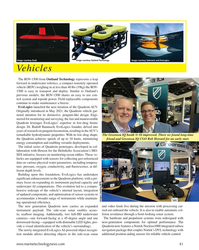 )
March 2024 - Marine Technology Reporter page: 41
)
March 2024 - Marine Technology Reporter page: 41Image courtesy Outland Technology Image courtesy Exail Image courtesy Submaris and EvoLogics Vehicles The ROV-1500 from Outland Technology represents a leap forward in underwater robotics, a compact remotely operated vehicle (ROV) weighing in at less than 40 lbs (19kg) the ROV- 1500 is easy to transport
-
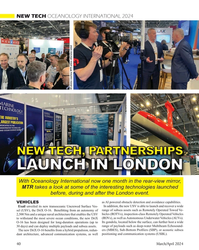 )
March 2024 - Marine Technology Reporter page: 40
)
March 2024 - Marine Technology Reporter page: 40NEW TECH OCEANOLOGY INTERNATIONAL 2024 All photos courtesy MTR unless otherwise noted NEW TECH, PARTNERSHIPS LAUNCH IN LONDON With Oceanology International now one month in the rear-view mirror, MTR takes a look at some of the interesting technologies launched before, during and after the London event.
-
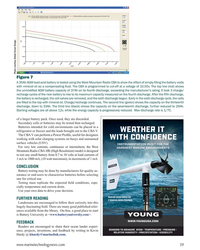 )
March 2024 - Marine Technology Reporter page: 39
)
March 2024 - Marine Technology Reporter page: 39Photo courtesy Global Ocean Design Figure 7 A 35Ah AGM lead-acid battery is tested using the West Mountain Radio CBA to show the effect of simply ? lling the battery voids with mineral oil as a compensating ? uid. The CBA is programmed to cut-off at a voltage of 10.50v. The top line (red) shows the
-
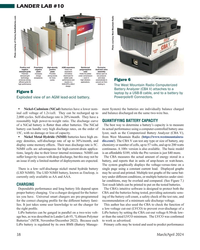 )
March 2024 - Marine Technology Reporter page: 38
)
March 2024 - Marine Technology Reporter page: 38LANDER LAB #10 Photo courtesy West Mountain Radio Photo courtesy of Clarios/AutoBatteries.com Figure 6 The West Mountain Radio Computerized Battery Analyzer (CBA V) attaches to a Figure 5 laptop by a USB-B cable, and to a battery by Powerpole® Connectors. Exploded view of an AGM lead-acid battery.
-
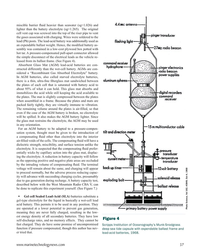 )
March 2024 - Marine Technology Reporter page: 37
)
March 2024 - Marine Technology Reporter page: 37miscible barrier ? uid heavier than seawater (sg=1.026) and lighter than the battery electrolyte (sg=1.265). The original cell vent cap was screwed into the top of the riser pipe to vent the gases associated with charging. Wires were soldered to the lead (Pb) posts. The lead-acid battery was additionall
-
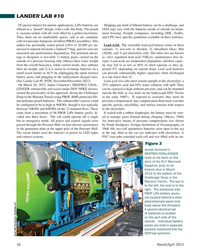 )
March 2024 - Marine Technology Reporter page: 36
)
March 2024 - Marine Technology Reporter page: 36LANDER LAB #10 Of special interest for marine applications, LiPo batteries are Shipping any kind of lithium battery can be a challenge, and offered in a “pouch” design, with a soft, ? at body. The pouch IATA regs vary with the batteries inside or outside an instru- is vacuum-sealed, with all voids ?
-
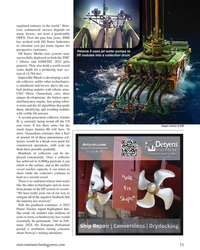 )
March 2024 - Marine Technology Reporter page: 33
)
March 2024 - Marine Technology Reporter page: 33regulated industry in the world.” How- ever, commercial success depends on many factors, not least a predictable OPEX. Over the past four years, SMD has worked with Oil States Industries to calculate cost per tonne ? gures for prospective customers. Patania II uses jet water pumps to Oil States’
-
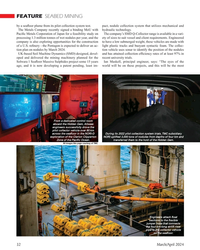 )
March 2024 - Marine Technology Reporter page: 32
)
March 2024 - Marine Technology Reporter page: 32FEATURE SEABED MINING by a sea? oor plume from its pilot collection system test. pact, nodule collection system that utilizes mechanical and The Metals Company recently signed a binding MoU with hydraulic technology. Paci? c Metals Corporation of Japan for a feasibility study on The company’s SMD
-
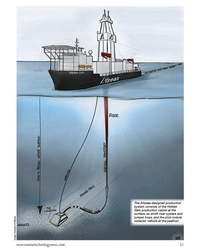 )
March 2024 - Marine Technology Reporter page: 31
)
March 2024 - Marine Technology Reporter page: 31The Allseas-designed production system consists of the Hidden Gem production vessel at the surface, an airlift riser system and jumper hose, and the pilot nodule collector vehicle at the sea? oor. Image courtesy of Allseas www.marinetechnologynews.com 31 MTR #3 (18-33).indd 31 4/4/2024 2:12:41
-
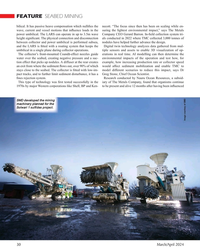 )
March 2024 - Marine Technology Reporter page: 30
)
March 2024 - Marine Technology Reporter page: 30FEATURE SEABED MINING bilical. It has passive heave compensation which nulli? es the necott. “The focus since then has been on scaling while en- wave, current and vessel motions that in? uence loads in the suring the lightest environmental impact,” says The Metals power umbilical. The LARS can
-
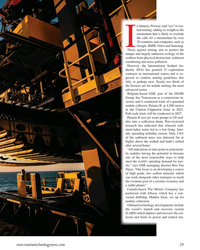 )
March 2024 - Marine Technology Reporter page: 29
)
March 2024 - Marine Technology Reporter page: 29n January, Norway said “yes” to sea- bed mining, adding its weight to the momentum that is likely to override the calls for a moratorium by over 20 countries and companies such as I Google, BMW, Volvo and Samsung. Those against mining aim to protect the unique and largely unknown ecology of the sea?
-
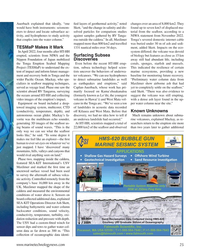 )
March 2024 - Marine Technology Reporter page: 25
)
March 2024 - Marine Technology Reporter page: 25Auerbach explained that ideally, “one ? ed layers of geothermal activity,” noted changes over an area of 8,000 km2. They would have both instruments: seismom- Skett, “and the change in salinity and dis- found up to seven km3 of displaced ma- eters to detect and locate subsurface ac- solved particles for
-
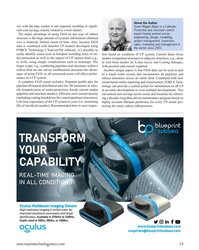 )
March 2024 - Marine Technology Reporter page: 19
)
March 2024 - Marine Technology Reporter page: 19About the Author vey with the pipe tracker is not required, resulting in signi? - Svenn Magen Wigen is a Cathodic Protection and corrosion control cant cost savings, mainly related to vessel charter. expert having worked across The major advantage of using FiGS on any type of subsea engineering, design
-
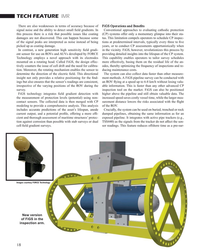 )
March 2024 - Marine Technology Reporter page: 18
)
March 2024 - Marine Technology Reporter page: 18TECH FEATURE IMR There are also weaknesses in terms of accuracy because of FiGS Operations and Bene? ts signal noise and the ability to detect small ? eld gradients. In Conventional approaches to evaluating cathodic protection this process there is a risk that possible issues like coating (CP)
-
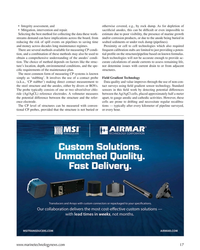 )
March 2024 - Marine Technology Reporter page: 17
)
March 2024 - Marine Technology Reporter page: 17• Integrity assessment, and otherwise covered, e.g., by rock dump. As for depletion of • Mitigation, intervention and repair. sacri? cial anodes, this can be dif? cult or even impossible to Selecting the best method for collecting the data these work- estimate due to poor visibility, the presence of
-
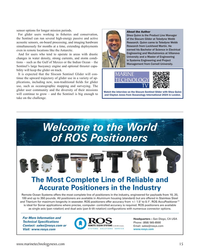 )
March 2024 - Marine Technology Reporter page: 15
)
March 2024 - Marine Technology Reporter page: 15sensor options for longer mission periods. About the Author For glider users working in ? sheries and conservation, Shea Quinn is the Product Line Manager the Sentinel can run several high-energy passive and active of the Slocum Glider at Teledyne Webb acoustic sensors, on-board processing, and imaging
-
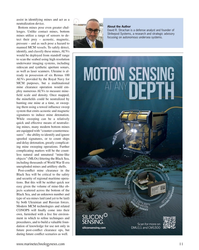 )
March 2024 - Marine Technology Reporter page: 11
)
March 2024 - Marine Technology Reporter page: 11assist in identifying mines and act as a neutralization device. About the Author Bottom mines pose even greater chal- David R. Strachan is a defense analyst and founder of lenges. Unlike contact mines, bottom Strikepod Systems, a research and strategic advisory mines utilize a range of sensors to
-
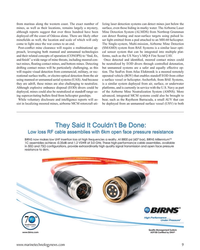 )
March 2024 - Marine Technology Reporter page: 9
)
March 2024 - Marine Technology Reporter page: 9from marinas along the western coast. The exact number of lizing laser detection systems can detect mines just below the mines, as well as their locations, remains largely a mystery, surface, even those hiding in murky water. The Airborne Laser although reports suggest that over three hundred have been
